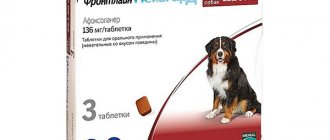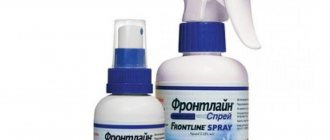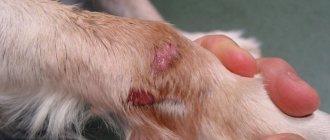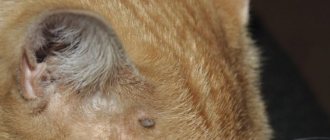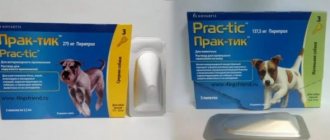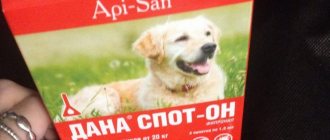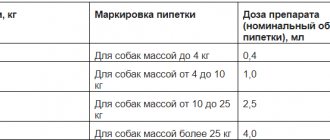French Frontline antiparasitic products are considered one of the best. They are often prescribed by veterinarians and recommended by breeders.
However, in recent years, the drugs have begun to be criticized. Some dog owners note a decrease in the effect, others indicate a weak effect, while others generally talk about frequent adverse reactions and mutagenic manifestations.
Is Frontline safe for dogs, how effective is it, is it worth buying this expensive drug, and are there any worthy analogues? We’ll look at it in this review.
Types of drugs and principle of action
The manufacturer produces the following types of Frontline drugs:
- Combo for dogs.
- Combo for ferrets and cats.
- Spot-on.
- Spray.
- Tri-ACT.
The list of active ingredients and their concentration in the preparations is shown in the table:
| Name | Concentration of active substances, % | ||
| Fipronil | S-methoprene | Permethrin | |
| Combo for dogs | 10 | 9 | |
| Combo for cats and ferrets | 10 | 12 | |
| Spot he | 10 | ||
| Spray | 0,25 | ||
| Tri-ACT | 6,76 | 50,48 | |
Fipronil and Permethrin interrupt the transmission of nerve signals to the muscles of arthropods, immobilizing them. Methoprene is structurally reminiscent of an arthropod hormone that is involved in the synthesis of chitin. In immature forms, the maturation process stops. The larval stages may not survive to the age where they can reproduce.
Frontline components do not enter the bloodstream, accumulate in the sebaceous glands, hair follicles, epidermis, hairs and provide long-term protection against parasites.
How it works
The action of Frontline depends on the form of release. Thus, drops on the withers (Spot On, Tri-Act, Combo) and spray almost do not penetrate the body and do not enter the systemic bloodstream. After application, the active components spread over the entire surface of the skin, accumulate in the cells of the epidermis, hair follicles and sebaceous glands, from where they are released along with the secretion.
But drugs in the form of tablets (NexgarD and Spectra) work systemically. The active substances included in their composition are absorbed by the walls of the stomach and intestines, enter the systemic circulation and accumulate in the plasma. Their maximum concentration is observed in the body after 30 minutes or 2-4 hours, and the elimination period ranges from 1.5 days to a month (depending on the type of component).
The effects of the components vary depending on their type:
- Fipronil. It disrupts the transmission of nerve impulses in insects, leading to their paralysis and death. Included in Spot-On, Combo, Spray, Tri-Act.
- S-methoprene. Inhibits the growth of blood-sucking parasites by disrupting chitin synthesis and prevents insects from reaching sexual maturity. Contained in Combo.
- Permethrin. It has an insectoacaricidal (deadly) and repellent (repellent) effect. Used in Tri-Act.
- Afoxolaner. Blocks insect receptors and the transmission of nerve impulses, which causes paralysis and subsequent death. Active ingredient: NexgarD and Spectra.
- Milbemycin oxime. Works against all forms of nematode development, as well as heartworm larvae. Increases the permeability of cell membranes, which causes paralysis and death of helminths. Used in Spectrum.
The duration of the protective effect also varies among different forms:
- Spot It prevents infection by ticks for up to 35 days, fleas - 4-12 weeks;
- The combo works: up to 28 days against ixodid ticks, 4-12 weeks against other insects;
- The spray works: 3-5 weeks against ixodid ticks, 1-3 months against fleas;
- Three-Act destroys fleas within a day, and within two days – lice-eaters, sarcoptic and ixodid ticks, the preventive effect lasts 4-5 weeks, during this period it also repels mosquitoes, mosquitoes and burn flies;
- NexgarD begins to work half an hour after administration, destroys fleas in 6 hours, ticks in two days, remains effective for a month, gets rid of parasites before egg laying - this prevents re-infestation and the spread of insects in the house;
- Spectra is similar in action to NexgarD, only it gets rid of ticks 2 times faster - within 24 hours.
Other products in the series
There is a whole series of “Frontline” medications; we will consider each drug separately.
Frontline Nexgard
Delicious (beef flavored) chewable tablets that help quickly get rid of parasites. The tablet begins to act within half an hour after use. One application is enough to forget about ticks/fleas for a whole month.
Frontline Spray
This product is for puppies, kittens and small breeds of animals weighing less than two kilograms. The substance is safe and can be used from the second day of life. The drug is economical and easy to use.
Frontline Triact
For use on dogs only. Helps get rid of mosquitoes, flies, sand flies, fleas and ticks. It acts quickly, fleas begin to die within 5 minutes after application, and ticks die within six hours.
Indications for use
All drugs in the Frontline series are prescribed to cure parasites and prevent their infection. So, they help from:
- fleas;
- lice eaters;
- ixodid ticks;
- scabies (sarcoptoid) mites – Spray, NexgarD and Spectra do not work against them;
- lice;
- mosquitoes
The Tri-Act form also has a repellent and insecticidal effect against dipterous insects: mosquitoes, burner flies, mosquitoes. And NexgarD Spectra destroys the larvae of heartworms and gastrointestinal nematodes: toxocara, hookworm, trichocephalosis.
Any medicine from Merial is indicated for:
- entomosis – diseases caused by insects;
- acaroses – pathologies that arose due to mites;
- otodectosis - ear scabies;
- allergic dermatitis caused by fleas (in complex therapy).
If, in addition to these conditions, there is a risk of contracting dirofilariasis, NexgarD Spectra is prescribed.
Frontline combo
The working fluid is poured into pipettes with a volume of 0.5; 0.67; 1.34; 2.68; 4.02 cm3.
Cost in September 2022 - 605 rubles.
Frontline combo destroys lice eaters, fleas, ixodid and sarcoptic ticks, and mosquitoes. The treatment destroys ticks within 48 hours and other insects within 24 hours.
The tip of the Frontline combo pipette is broken off and squeezed onto clean, intact skin in places that are inaccessible for licking. The drug protects against attacks by ixodid ticks for 4 weeks. The repellent time against fleas and lice for cats and ferrets is 42 days, for dogs - 12 weeks. The drug is used as needed, at intervals of at least three weeks.
Dosage the insectoacaricide according to the scheme:
| Live weight, kg | Pipette volume, ml |
| Dogs | |
| >2<10 | 0,67 |
| >10<20 | 1,34 |
| >20<40 | 2,68 |
| >40 | 4,02 |
| Cats, ferrets | 0,5 |
Frontline is not prescribed to puppies up to 2 kg, kittens up to 8 weeks and weighing up to 1 kg, ferrets up to 6 months. The drug is prescribed to lactating animals under the supervision of a veterinarian. The female is isolated from the cubs for half an hour or more until the applied insectoacaricide dries. Frontline combo is toxic to decorative rabbits. After treatment, the pet should not be allowed to get wet for two days.
The drug is stored for 3 years at temperatures from 0 to 30 °C.
Instructions for use and dosage
The nuances of using Frontline depend on the specific type of drug.
Drop shape
Spot On, Tri Act or Combo is applied to dry, uninjured skin in two places: at the base of the back of the head and between the shoulder blades. To do this, fix the pet and squeeze the solution out of the pipette, spreading the fur.
If the dog has otodectosis, the solution is instilled in 4-6 drops into both ears, and the remainder is squeezed out of a pipette between the shoulder blades.
Dosages are selected by purchasing the drug for the appropriate size. If the dog weighs more than 60 kg or its weight is in borderline values, combine 2 pipettes, whose total volume will be as close as possible to the weight of the pet.
Drops are used in the following dosages. Spot On:
Combo:
Three-Act:
Spray Form
The spray is more convenient in terms of dosage selection. It is used like this:
- the treatment is carried out in the yard or in a ventilated area (with open windows and doors);
- pre-cover aquariums, remove cages with ornamental birds, move away from the hives;
- put a muzzle, a collar on the dog, or tighten the jaws with tape - they are not removed until the solution has completely dried, so that the pet does not lick the drug;
- The bottle with the spray is shaken and, holding it vertically, sprayed at a distance of 10-20 cm;
- apply the solution to the entire body of the dog in the direction against hair growth, lift the long hair with your hand;
- then close the animal’s eyes and nose and carefully spray the spray onto the chest and ears;
- Rub the product around the eyes and nose with your fingers.
Dosages for the Spray are as follows:
After applying drops or spray treatment, the pet is not bathed (with water or shampoo) for 48 hours. During this same period, they do not allow him to swim in bodies of water; they make sure that he does not run through puddles or roll around in mud or rotten meat.
Tablet form
Dogs usually eat the chewable tablets themselves. But if the dog refuses to eat them, the capsule can be given in 3 ways:
- disguise it in the stern;
- wrapped in a piece of delicacy: minced meat, cheese or butter;
- force-feed by opening the jaws and placing the pill on the root of the tongue.
Dosages for NexgarD:
Dosages for NexgarD Spectra:
Select tablets according to the weight of the animal and the appropriate labeling. If the dog weighs over 50 kg, combine 2 capsules with different contents of components that are most suitable for the pet’s weight. You cannot break the pills.
Make sure the pet swallows the tablet. If he spits it out or vomits soon after giving the medicine, he is fed again in the same dosage.
Contraindications
The drug Frontline is not toxic to cats, so the list of contraindications for using the drug consists of only two points:
- Individual intolerance to the drug in animals;
- The age of the kitten is 1 day after birth.
Possible side effects:
Hypersalivation.
Important!
If side effects occur, you should immediately stop using Frontline and wash it off your pet's fur. In case of severe allergic reactions, it is necessary to consult a veterinary doctor for help and administer anti-allergy drugs.
In addition, when choosing a particular product, it is important to pay attention to what age or weight of the animal it is intended for. The product range of this manufacturer allows you to select suitable drugs for both adults and kittens. This is especially convenient for those owners who have not one cat, but several pets of different ages.
This is especially convenient for those owners who have not one cat, but several pets of different ages.
In the range of the series you can find:
By the way, Frontline drops and sprays intended for cats can also be used for ferrets, which are increasingly found as pets. What are the specific features of certain Frontline tools?
Drug safety studies
The instructions indicate that, according to GOST 12.1.007-76, medicines from the Spot On, Tri-Act, Combo and Spray lines belong to the 3rd hazard class (moderately hazardous substances), and NexgarD and Spectra - to the 4th class ( low-hazard substances). These results are confirmed by research from the manufacturer.
For the experiment, 4 primary groups were formed. The first was not treated with medication, the second received the drug in a single dosage, the third in a three-fold dosage, and the fourth in a five-fold dosage. The condition of the animals was monitored using clinical tests, skin biopsy, and histological studies.
The results of the analyzes showed that there were no differences in the well-being and condition of the pets of different control groups.
Additionally, a similar analysis was carried out on puppies. It was found that in some kittens, the antiparasitic agent leads to increased discharge from the eyes and the formation of dandruff. But in general, children tolerate the medication well.
Today, the results of pharmacological research continue. Over the entire period of the program, Frontline has treated over 3 million animals of different ages, sizes and breeds. Only isolated cases of treatment regarding side effects were recorded. However, all of them were not directly related to the use of the drug - it could only influence the occurrence of negative reactions indirectly.
However, a number of breeders claim that the medication has a mutagenic effect. In particular, there have been cases of puppies being born with conjunctivitis and dermoids of the eyelids from parents who previously gave birth to healthy litters. These data have not been clinically confirmed, but they should be taken into account by nursery owners.
Frontline Spot on
The drug is packaged in polymer pipettes of 0.5; 0.67; 1.34; 2.68; 4.02 ml.
The cost in September 2022 is 530 rubles.
A single treatment kills ticks and fleas in 48 and 28 hours, respectively. Frontline Spot protects pets from ticks for 28 days. The duration of the repellent effect against fleas for cats is 6, for dogs - 12 weeks.
The drug is used as part of the complex treatment of flea dermatitis, as well as otodectosis. In the latter case, the drug is administered once into both ears, having previously cleared them of crusts and exudate. If the second hearing organ is clinically healthy, it is also treated.
The drug is dosed depending on the weight of the animal according to the following scheme:
| Kind of animal. Live weight, kg | Volume, ml |
| Cats | 0,5 |
| Dogs | |
| >2<10 | 0,67 |
| >10<20 | 1,34 |
| >20<40 | 2,68 |
| >40 | 4,02 |
| Cats, ferrets | 0,5 |
The drug is not prescribed to kittens up to 1 kg, puppies up to 2 kg. Animals must be over 56 days old. To prevent the cubs from licking the liquid applied to the mother’s back, the female is removed before the drug is absorbed into the skin. In order not to inactivate the effect of Fipronil, the animal should not be allowed to bathe in open water or get wet.
Frontline Spot is stored for 3 years at temperatures from 0 to 30 °C.
Updated generation of insecticides
New generation drugs include Frontline Nexgard and Nexander Spectra. The first effectively fights blood-sucking parasites, and the second cleanses the body of helminths.
These two products are produced in the form of tablets, but not ordinary ones, but chewable ones, with a pleasant smell and taste.
Benefits of the insecticide:
- ideal for animals that require frequent bathing and shampooing;
- used for pets with skin diseases;
- can be mixed into food or given separately;
- thirty minutes is the time during which the tablet completely dissolves;
- as soon as the medicine takes effect, you can safely contact your pet and let him near other puppies and children;
- One dose of medication is enough to cleanse the dog’s body of parasites;
There are four dosage options for the drug:
- for animals weighing 2-4 kilograms, the dose is 11.3 milligrams;
- 4.1-10 kilograms – 28.3 milligrams;
- 10.1-25 kilograms – 68 milligrams;
- 25.1-50 kilograms – 136 milligrams.
If your pet's weight exceeds 50 kilograms, you can calculate the dose yourself: 2.5 milligrams per kilogram of weight.
The drug is contraindicated for puppies less than two months old or weighing less than 2 kilograms.
Frontline anti-tick tablets can be given to pregnant and lactating animals without restrictions.
Skin parasites of cats
The most common and common in cats are:
- Fleas choose not only animals as victims, but also humans. Insects actively jump on the animal's skin and are easy to notice. More than 60 species of blood-sucking parasites carry over 200 diseases: anthrax, typhoid fever, salmonellosis, helminthiasis, and various fungal infections. Adult fleas do not live on the victim's body 24 hours a day. Having had enough, they leave the cat.
- Lice eaters are small wingless insects. They feed on particles of fur and epidermis, and blood. Like other ectoparasites, lice eaters force the cat to constantly scratch the skin until wounds appear. Damaged skin is easily attacked by pathogenic bacteria. When a cat is infected with a lice-eater, sleep and appetite are disrupted, immunity decreases, and allergies occur.
- Lice - when infested with lice, the animal behaves restlessly, scratches the skin, and loses hair. Lice are easy to spot. On your pet's light coat, black dots that look like dirt and dust are clearly visible - these are parasite excrement. In case of mass infection, the animal faces dermatitis and complete baldness. Lice are carried by helminth larvae.
- Ixodid ticks - attack cats in the warm season. These small insects feed on blood and grow greatly in size. A swollen tick can be noticed immediately. A cat's skin and fur are very sensitive, so the animal can easily shake off an unattached tick from its skin. In search of food, insects willingly move onto people. Ticks carry many diseases: viral encephalitis, typhus, tularemia, hemorrhagic fever, piroplasmosis, helminthiasis, etc.
- Scabies mites live on the skin of a cat, gnawing passages in the inner layer of the dermis. They feed on epithelial cells and lymph. From a sick animal the tick is transmitted to people.
- Sarcoptoid mites are the cause of scabies. The peculiarity of this form is the rapid baldness of the ears, belly and muzzle.
- Ear mites - attack the animal's hearing system. The cat shakes its head and tries to get its hind paw inside the ear. Dark brown crusts form in the ears, followed by pus. Without treatment, the parasites gradually penetrate through the inner ear into the brain, and the animal dies.
- Heartworms (dirofilaria) cause one of the most dangerous diseases, dirofilariasis. The helminth larvae enter the mouthparts of the mosquito with the blood of the infected creature, and with the next bite the parasites enter the body of the final victim. They live under the skin, in the muscles of internal organs. Parasites destroy the heart, lungs, and coronary vessels. Without treatment, the animal faces death.
Photo gallery: dangerous cat ectoparasites
Fleas are the most common skin parasites
Hairworm - the cause of focal baldness in cats
Cat lice are as common as fleas, although they are less well known.
Hungry and well-fed ticks are very different in appearance
Getting rid of ear mites is a long and expensive task.
Heartworm is the causative agent of dirofilariasis, spread by mosquitoes.
Frontline spray
The aerosol product is produced in bottles of 100; 250 ml.
The cost of a 100 ml bottle in September 2022 is 845 rubles.
The spray protects cats from ixodid ticks for 3 weeks, fleas - 6 weeks. The dogs will be free of ectoparasites for 5 and 12 weeks respectively. Dispense the drug with the number of presses on the spray head in accordance with the table:
| Live weight, kg | Number of clicks | |
| 100 ml | 250 ml | |
| 5 | 30 | 10 |
| 10 | 60 | 20 |
| 15 | 90 | 30 |
| 25 | 150 | 50 |
The table provides recommendations for treating pets with short hair. For long-haired dogs, the number of presses is doubled. To prevent a cat or dog from licking the insecticide, place a neck collar, muzzle, or tie the closed jaws with a rope while it dries. Avoid contact of the aerosol with the eyes. Problem areas are treated with your finger after wearing gloves.
The animal should not be allowed to get wet for two days after treatment. There are no restrictions on the weight and age of the animal. The aerosol is stored for 2 years at temperatures from 0 to 25 °C.
Precautionary measures
When treating an animal with drugs in liquid form, care must be taken to ensure that the drug does not come into contact with the mucous membranes of the mouth, nose, or eyes of a person or animal. If the medicine gets into these areas, you should quickly rinse the affected areas with plenty of warm water. The person carrying out the treatment must not drink, eat, smoke, or put their hands near their face. After completing all manipulations, wash your hands twice with soap.
Before using the drug, you should check with your veterinarian about the interactions of Frontline drugs with other medications. Before starting therapy, it is imperative to conduct an allergy test to avoid the development of pronounced negative consequences.
Frontline products cannot be used simultaneously with antiparasitic collars.
Side effects and contraindications
Frontline drugs have a small number of contraindications and side effects, all of them are indicated in the instructions for use; in addition, you can consult a veterinarian.
Drops and spray should be used strictly in accordance with the age and weight indicated on the package. In rare cases, pets experience short-term allergic reactions in the form of redness, swelling, itching and rashes on the skin. If the animal becomes restless and tries to scratch its skin, you need to show the dog to the veterinarian, otherwise wounds and erosions may occur.
The tablets are contraindicated in case of kidney and liver pathologies, the presence of infectious diseases, and they are not used to treat weakened pets. Possible side effects are vomiting, diarrhea. In such situations, you need to give the medicine again or replace it with an analogue. Most often, negative reactions occur in herding breed dogs.
Answers to frequently asked questions
Recently the dog was treated with another antiparasitic agent. How quickly can Frontline be applied?
There should be at least a month between the use of different drugs. Carefully read the instructions for the previously used drug - it should contain instructions.
My pet weighs less than 2 kg. How should I treat him for fleas and ticks?
In such cases, it is recommended to use a spray form. The remaining types of drugs are designed for dogs weighing from 2 kg.
I am pregnant. Can I treat my dogs with medication myself?
Information about the dangers of Frontline for people, incl. during pregnancy, no. But it is better to ask another person to perform the procedure. If this is not possible, use gloves and then wash your hands thoroughly up to the elbows with soap.
I treated the dog with medicine, but soon found a tick on him. What to do?
The parasite must be removed quickly and carefully.
What else you need to know
Types of Frontline drops Frontline drops for dogs, reviews confirm this, are in great demand among consumers. After all, they can be used even by pregnant and lactating dogs. However, the drug also has some limitations. The product is contraindicated for treatment:
- puppies under 2 months of age;
- dogs weighing less than 2 kg;
- pets suffering from individual intolerance to the components included in the medicine.
Frontline drops for dogs cannot be used on cats. For mustachioed pets, the Merial company produces a similar drug that differs in dosage. For dogs, other drops that have proven themselves in the treatment process can be purchased at veterinary pharmacies:
- Barrier;
- Dana Ultra Neo;
- Blokhnet;
- Inspector;
- Leopard;
- Celandine.
Analogues of the drug
The selection of similar medications depends on which particular release form of Frontline needs to be replaced. The following analogues are produced:
| Name | What is the difference | Prices |
| Insectoacaricidal spray Bars | Made with fipronil. Do not use on pregnant and lactating females, as well as puppies. There is an improved formula “Forte” with diflubenzuron (0.1%) - the substance accumulates in the sebaceous glands and prolongs the effect of the drug. | Bars Forte – 330 rub. for a 100 ml bottle, regular: 260 rub. – for 100 ml, 375 rub. for 200 ml. |
| Hartz UltraGuard Plus Flea and Tick Spray for Dogs | The drug is in the form of a spray based on tetrachlorvinphos (1.08%) and methoprene (0.07%). Shorter duration: prevents infection by adult insects for up to 7 days, eggs – up to 4 weeks. Prohibited for puppies up to 1.5 months. | RUB 1,050 |
| Bravecto | Synonymous with Frontline Nexgard. Available in 2 types: drops on the withers and tablets. Works against exoparasites. Lasts longer - up to 12 weeks. | 800 – 1,500 rub. depending on the release form and dosage. |
| Reksolin Plus | Analogous to Frontline Spot on and Combo. The composition is similar in the presence of fipronil and methoprene. | 400-600 rub. depending on the species and the weight of the animal. |
| Hartz Ultra Guard drops | The action is similar to Frontline Three Act. However, they contain another active ingredient – phenothrin (85.7%). Allergic reactions, vomiting, and muscle tremors are possible. | 740 rub. |
| Stronghold | Synonymous with Spot On and Combo. It has a wider spectrum of action: kills fleas, ticks, roundworms and heartworms. | 1,500 per pack of 3 pipettes. |
| Advocate | Another drops of complex action. Helps against fleas and ticks. However, they are not effective against the parasites that cause ear scabies. But they work against helminths. | 1,200 rub. |
Owner reviews
Tamara, Pumice
“I noticed that the dog began to itch frequently, it turned out to be fleas. I don’t know where he could have picked them up, but the parasites appeared, so he had to look for a way to get rid of them. The veterinary pharmacy recommended an expensive and, as I was told, more effective remedy - Frontline Combo. On the second day after use, I found two dead fleas on the dog’s body and decided that I was done with them. But the dog did not stop itching, and after a couple of days I saw live fleas, I conclude that the money was wasted. I had to go to the vet clinic. The doctor recommended another remedy that relieved the pet of parasites.”
Irina, Moscow
“I chose Frontline Combo because I saw on the packaging that it destroys not only adult parasites, but also their larvae. The price, of course, is steep, but nothing is a pity for your beloved pet. I bought it and applied it to the withers. After two days, I noticed that the dog stopped itching and generally began to look noticeably more cheerful. In general, the medicine helps against fleas well. I recommend!”
conclusions
The drugs are generally good products that will destroy the parasites that have already settled on your pet and prevent subsequent infestations. The only thing is that it is better not to take Spectra, but to independently select an anthelmintic with a wider spectrum of action: Canikquantel, Drontal, Profender, Milbemax, Alben S, etc.
For several years I prescribed Frontline without fear. But lately there are a few things to consider:
- counterfeits have become more frequent;
- the clinic is often contacted about negative reactions after using drugs;
- Entomoses and acaroses are becoming increasingly common in animals treated with drugs from Merial.
It is also impossible to ignore the observations of breeders who note mutagenic effects in litters of healthy purebred dogs and even mongrels, in which the risk of recessive genes and associated hereditary diseases is minimal. Although no research has been done on this, keep this point in mind.
Frontline drops, spray and tablets are controversial drugs. In most cases, they work well and do not affect the dogs' health. But it may cause side effects or may not work in some animals. Therefore, there is a reason to choose another medication: Bravecto, Bars, Hartz, Rexolin.
Interesting read: What kind of dog to have in an apartment
What danger do ticks and fleas pose to dogs?
Dog fleas are carriers of deadly diseases such as salmonellosis, brucellosis, and plague. Parasites can infect pets with worms. At the same time, fleas easily move onto humans, carrying with them such dangerous diseases as anthrax and encephalitis. The movement of fleas through the animal's fur causes itching, which can lead to skin problems and the appearance of allergic dermatitis and anemia.
Ticks are no less dangerous blood-sucking parasites, which are primarily carriers of piroplasmosis, which has fatal consequences. When infected, fever, anemia, and dark-colored urine appear. The dog refuses to eat and behaves lethargically. By identifying symptoms early and seeking veterinary help, your pet can be saved.
Therefore, when insects appear on an animal, it is necessary to urgently begin to combat the parasites.
Side effects
No side effects were identified when using the drug.
If the recommended dosage is exceeded by more than three times, increased salivation, vomiting and tremors are possible.
Local allergic reactions are possible. If they are detected, it is necessary to wash it off and give the pet an antihistamine. Next, the spray must be replaced with another antiparasitic drug to prevent recurrent allergies.
In case of side effects, it is necessary to thoroughly wash the solution from the dog’s coat and skin and prescribe symptomatic treatment (absorbents and antihistamines).
If the drug gets on the mucous membranes, it is necessary to rinse them thoroughly with running water.
